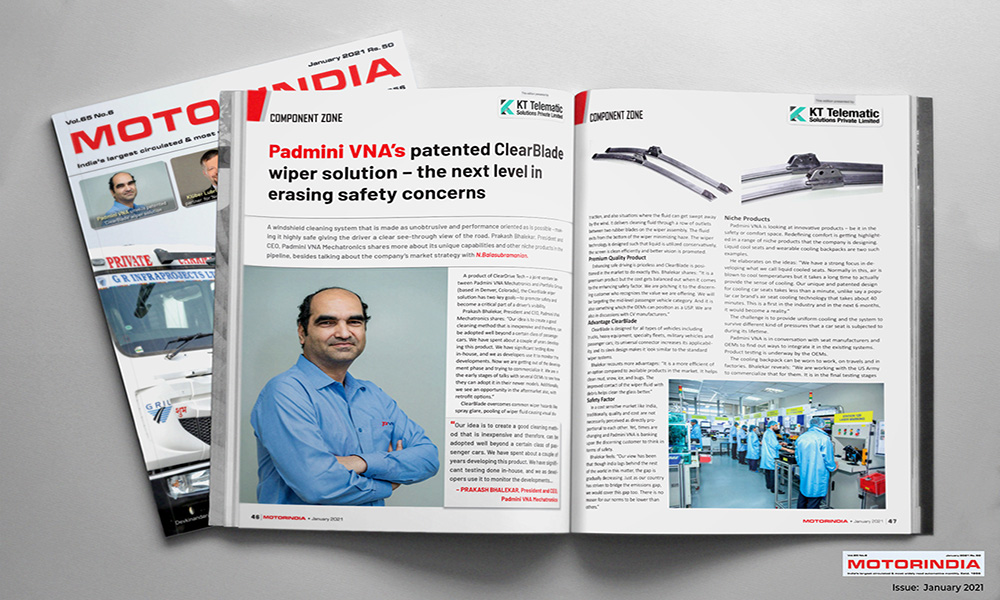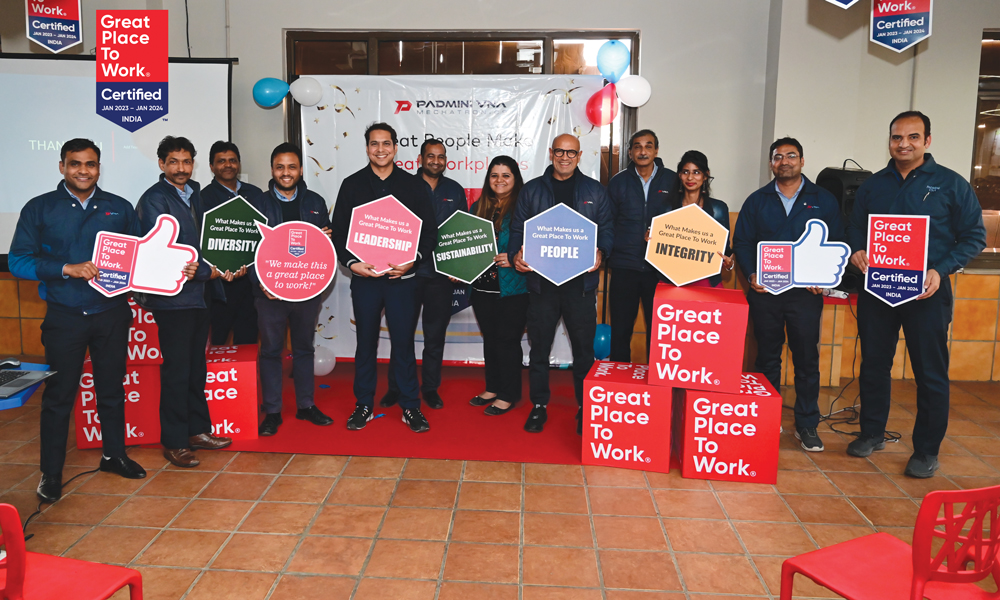

A windshield cleaning system that is made as unobtrusive and performance oriented as is possible – making it highly safe giving the driver a clear see-through view of the road. Prakash Bhalekar, President and CEO, Padmini VNA Mechatronics shares more about its unique capabilities and other niche products in the pipeline, besides talking about the company’s market strategy with N.Balasubramanian.
A product of ClearDrive Tech – a joint venture between Padmini VNA Mechatronics and iPortfolio Group (based in Denver, Colorado), the ClearBlade wiper solution has two key goals—to promote safety and become a critical part of a driver’s visibility.
Prakash Bhalekar, President and CEO, Padmini VNA Mechatronics shares: “Our idea is to create a good cleaning method that is inexpensive and therefore, can be adopted well beyond a certain class of passenger cars. We have spent about a couple of years developing this product. We have significant testing done in-house, and we as developers use it to monitor the developments. Now we are getting out of the development phase and trying to commercialize it. We are in the early stages of talks with several OEMs to see how they can adopt it in their newer models. Additionally, we see an opportunity in the aftermarket also, with retrofit options.”
ClearBlade overcomes common wiper hazards like spray glare, pooling of wiper fluid causing visual distraction, and also situations where the fluid can get swept away by the wind. It delivers cleaning fluid through a row of outlets between two rubber blades on the wiper assembly. The fluid exits from the bottom of the wiper minimizing haze. The wiper technology is designed such that liquid is utilized conservatively, the screen is clean efficiently and better vision is promoted.
Premium Quality Product
Enhancing safe driving is priceless and ClearBlade is positioned in the market to do exactly this. Bhalekar shares: “It is a premium product but the cost gets balanced out when it comes to the enhancing safety factor. We are pitching it to the discerning customer who recognizes the value we are offering. We will be targeting the mid-level passenger vehicle category. And it is also something which the OEMs can position as a USP. We are also in discussions with CV manufacturers.”
Advantage ClearBlade
ClearBlade is designed for all types of vehicles including trucks, heavy equipment, specialty fleets, military vehicles and passenger cars; its universal connector increases its applicability, and its sleek design makes it look similar to the standard wiper systems.
Bhalekar recounts more advantages: “It is a more efficient of an option compared to available products in the market. It helps clean mud, snow, ice, and bugs. The improved contact of the wiper fluid with debris helps clean the glass better.”
Safety Factor
In a cost sensitive market like India, traditionally, quality and cost are not necessarily perceived as directly proportional to each other. Yet, times are changing and Padmini VNA is banking upon the discerning customer to think in terms of safety.
Bhalekar feels: “Our view has been that though India lags behind the rest of the world in this matter, the gap is gradually decreasing. Just as our country has striven to bridge the emissions gap, we would cover this gap too. There is no reason for our norms to be lower than others.”
Niche Products
Padmini VNA is looking at innovative products – be it in the safety or comfort space. Redefining comfort is getting highlighted in a range of niche products that the company is designing. Liquid cool seats and wearable cooling backpacks are two such examples.
He elaborates on the ideas: “We have a strong focus in developing what we call liquid cooled seats. Normally in this, air is blown to cool temperatures but it takes a long time to actually provide the sense of cooling. Our unique and patented design for cooling car seats takes less than a minute, unlike say a popular car brand’s air seat cooling technology that takes about 40 minutes. This is a first in the industry and in the next 6 months, it would become a reality.”
The challenge is to provide uniform cooling and the system to survive different kind of pressures that a car seat is subjected to during its lifetime.
Padmini VNA is in conversation with seat manufacturers and OEMs to find out ways to integrate it in the existing systems. Product testing is underway by the OEMs.
The cooling backpack can be worn to work, on travels and in factories. Bhalekar reveals: “We are working with the US Army to commercialize that for them. It is in the final testing stages and tooling up as required. These backpacks can both heat and cool.” Another avenue is the automotive industry where companies are interested in using them on their work floors for their staff. And it is a product that is fit for the aftermarket segment which the company is contemplating of entering.
BS-VI – Challenges and Opportunities
With BS-VI transition, there are more electronic components in place in the vehicles. He shares: “The content that we have per vehicle or per engine goes up dramatically. But there is going to be a hybridization phase before full electrification can happen and we are well placed to be active in that phase also. And we see the hybrid space growing to almost 15% of our total turnover over time.”
According to him, the volume of hybrids is increasing quite rapidly, and faster than electric vehicles.
He adds further: “We are looking at the global market besides at home and we see hybridization happening because the transition to electric will happen only when the infrastructure is in place. With a concerted effort, it can happen and India has always found a way to leapfrog. Though at the moment, the technology is not yet there for us to adopt widely. The battery manufacturing capacity in India is yet to develop. And we think that diesel will be replaced by hybrid as there is uncertainty in regulation.”
Different cities across India bar diesel vehicles from entering which creates space for hybrid vehicles and also the advantage is that hybrids consume almost the same operating cost as a diesel fueled vehicle.
According to Bhalekar, by the year 2025-2030, hybrid vehicles will be occupying more than 30-35% of the market share, while EV would still cover about 5%.
The 2020 Challenge
Padmini VNA began working on their disruptive and innovative products a couple of years ago. With the focus of the industry changing in the last year and a half to BS-VI, followed by the COVID pandemic, much of the industry’s attention was taken up by managing the situation. Bhalekar thinks the adoption for all the new technologies will start happening right about now.
He elaborates: “Year 2020 was extremely challenging. With the BS-VI launch, the engine manufacturers had tremendous changes in technology and manufacturing processes to absorb, that too in an extremely short time. But together we did it. In our view, almost 70% of our product was replaced by new products. COVID period was traumatic because all the investments that were made went splat and things went to standstill. But it seems like we will have a reasonably good future.”
2021 and Ahead
Padmini VNA is setting up their second factory in Gurgaon which is expected to go live by next year. And the officials are positive that the autonomous future will bring an increase in sensor placements on the windshield and the wipers will need to get smarter and dole out better performance – for which Padmini VNA is ready to cater to the requirements. Bhalekar shares: “In the next financial year, we will work on the OEM adoption and start building up the aftermarket segment.”
The company is looking at global markets including Germany, US, and China to name a few geographies. The expansion plans may take the shape of entering transmission and body areas too, since most of their products are powertrain-centric. Other products may include tail gate actuators, transmission solenoids and transmission pumps and the like.
—
“Our idea is to create a good cleaning method that is inexpensive and therefore, can be adopted well beyond a certain class of passenger cars. We have spent about a couple of years developing this product. We have significant testing done in-house, and we as developers use it to monitor the developments…
– Prakash Bhalekar, President and CEO, Padmini VNA Mechatronics